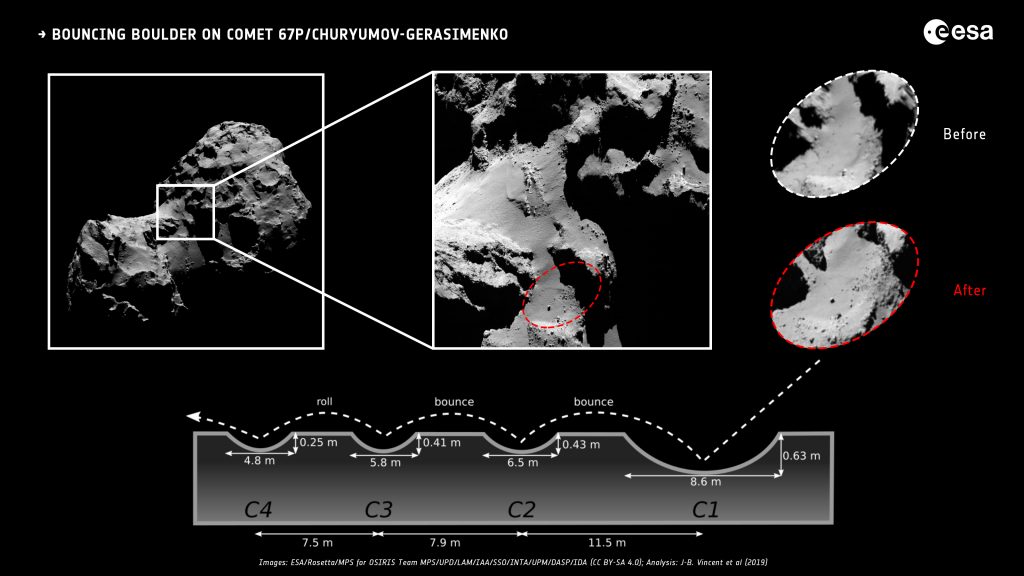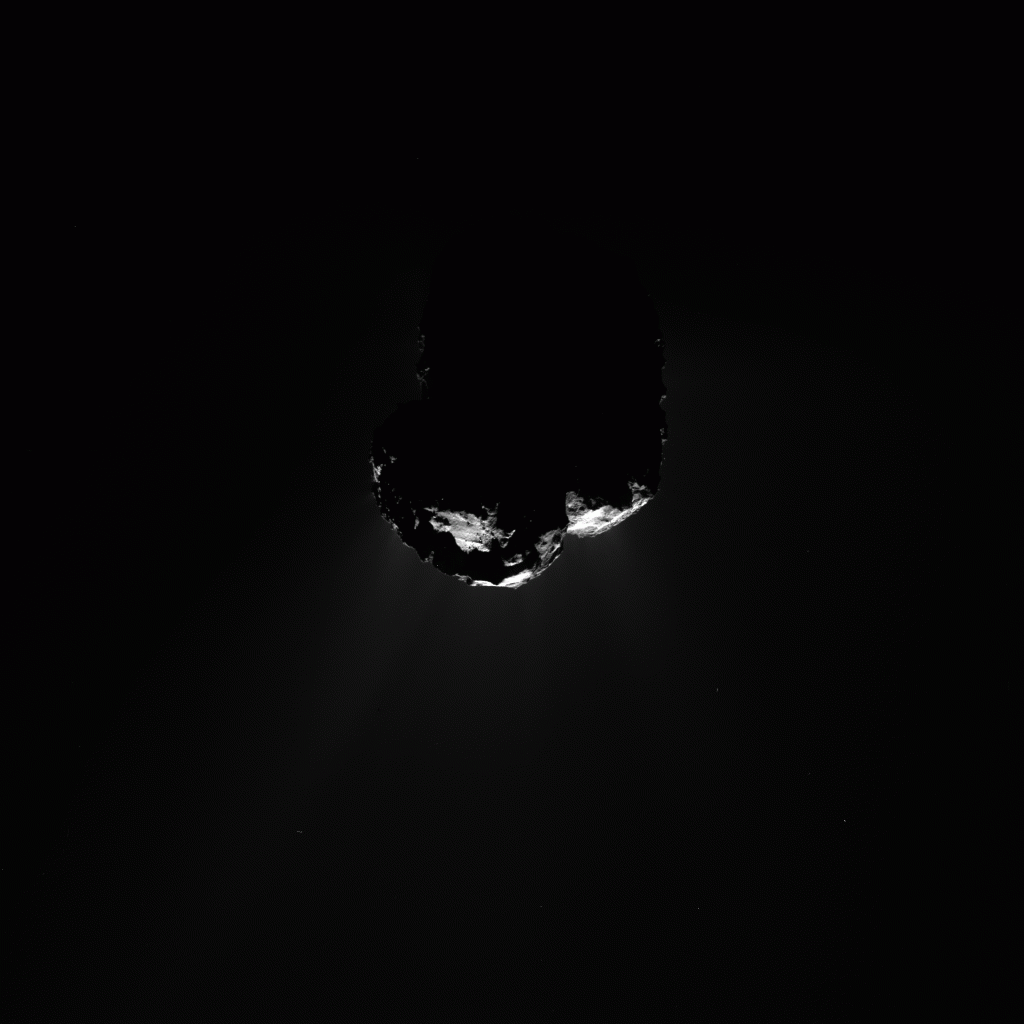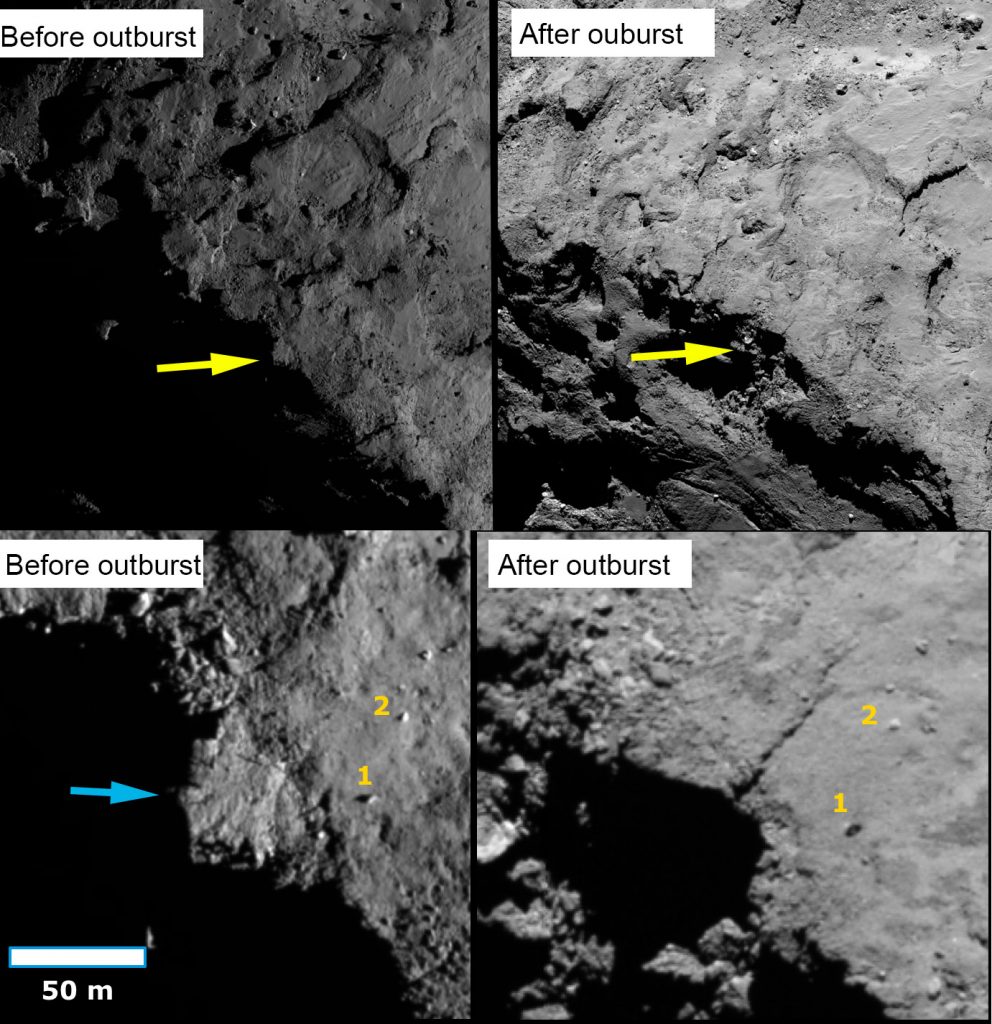Comet’s collapsing cliffs and bouncing boulders
Scientists analysing the treasure trove of images taken by ESA’s Rosetta mission have turned up more evidence for curious bouncing boulders and dramatic cliff collapses.
Rosetta operated at Comet 67P/Churyumov-Gerasimenko between August 2014 and September 2016, collecting data on the comet’s dust, gas and plasma environment, its surface characteristics and its interior structure.
As part of the analysis of some 76 000 high-resolution images captured with its OSIRIS camera, scientists have been looking for surface changes. In particular, they are interested in comparing the period of the comet’s closest approach to the Sun – known as perihelion – with that after this most active phase, to better understand the processes that drive surface evolution.
Loose debris is seen all over the comet, but sometimes boulders have been caught in the act of being ejected into space, or rolling across the surface. A new example of a bouncing boulder was recently identified in the smooth neck region that connects the comet’s two lobes, an area that underwent a lot of noticeable large-scale surface changes over the course of the mission. There, boulder about 10 m-wide has apparently fallen from the nearby cliff, and bounced several times across the surface without breaking, leaving ‘footprints’ in the loosely consolidated surface material.
“We think it fell from the nearby 50 m-high cliff, and is the largest fragment in this landslide, with a mass of about 230 tonnes,” said Jean-Baptiste Vincent of the DLR Institute for Planetary Research, who presented the results at the EPSC-DPS conference in Geneva today.
“So much happened on this comet between May and December 2015 when it was most active, but unfortunately because of this activity we had to keep Rosetta at a safe distance. As such we don’t have a close enough view to see illuminated surfaces with enough resolution to exactly pinpoint the ‘before’ location of the boulder.”
Studying boulder movements like these in different parts of the comet helps determine the mechanical properties of both the falling material, and the surface terrain on which it lands. The comet’s material is in general very weak compared with the ice and rocks we are familiar with on Earth: boulders on Comet 67P/C-G are around one hundred times weaker than freshly packed snow.
Another type of change has also been witnessed in several locations around the comet: the collapse of cliff faces along lines of weakness, such as the dramatic capture of the fall of a 70 m-wide segment of the Aswan cliff observed in July 2015. But Ramy El-Maarry and Graham Driver of Birkbeck, University of London, may have found an even larger collapse event, linked to a bright outburst seen on 12 September 2015 along the northern-southern hemisphere divide.
“This seems to be one of the largest cliff collapses we’ve seen on the comet during Rosetta’s lifetime, with an area of about 2000 square metres collapsing,” said Ramy, also speaking at EPSC-DPS today.
During perihelion passage, the southern hemisphere of the comet was subjected to high solar input, resulting in increased levels of activity and more intensive erosion than elsewhere on the comet.
“Inspection of before and after images allow us to ascertain that the scarp was intact up until at least May 2015, for when we still have high enough resolution images in that region to see it,” says Graham, an undergraduate student working with Ramy to investigate Rosetta’s vast image archive.
“The location in this particularly active region increases the likelihood that the collapsing event is linked to the outburst that occurred in September 2015.”
Looking in detail at the debris around the collapsed region suggests that other large erosion events have happened here in the past. Ramy and Graham found that the debris includes blocks of variable size ranging up to tens of metres, substantially larger than the boulder population following the Aswan cliff collapse, which is mainly comprised of boulders a few metres diameter.
“This variability in the size distribution of the fallen debris suggests either differences in the strength of the comet’s layered materials, and/or varying mechanisms of cliff collapse,” adds Ramy.
Studying comet changes like these not only gives insight into the dynamic nature of these small bodies on short timescales, but the larger scale cliff collapses provide unique views into the internal structure of the comet, helping to piece together the comet’s evolution over longer timescales.
“Rosetta’s datasets continue to surprise us, and it’s wonderful the next generation of students are already making exciting discoveries,” adds Matt Taylor, ESA’s Rosetta project scientist.
Cliff collapses on Comet 67P/Churyumov-Gerasimenko following outbursts as observed by the Rosetta mission, by M. R. El-Maarry and G. Driver
https://meetingorganizer.copernicus.org/EPSC-DPS2019/EPSC-DPS2019-1727-1.pdf
Bouncing boulders on Comet 67P by J-B. Vincent et al
https://meetingorganizer.copernicus.org/EPSC-DPS2019/EPSC-DPS2019-502-1.pdf

Caption: An example of a boulder having moved across the surface of Comet 67P/Churyumov-Gerasimenko’s surface, captured in Rosetta’s OSIRIS imagery.
The first image (left) provides a reference view of the comet, along with a close-up of the region under study. The smaller insets on the right show before and after images of the region containing the bouncing boulder, captured on 17 March 2015 and 19 June 2016, respectively. Impressions of the boulder have been left in the soft regolith covering the comet’s surface as it bounced to a halt. It is thought to have fallen from the nearby cliff, which is about 50 m high. The graphic at the bottom illustrates the path of the boulder as it bounced across the surface, with preliminary measurements of the ‘craters’ calculated.
Credits: Images: ESA/Rosetta/MPS for OSIRIS Team MPS/UPD/LAM/IAA/SSO/INTA/UPM/DASP/IDA (CC BY-SA 4.0); Analysis: J-B. Vincent et al (2019)


Caption: Before and after a cliff collapse on Comet 67P/Churyumov-Gerasimenko. In the upper panels the yellow arrows show the location of a scarp at the boundary between the illuminated northern hemisphere and the dark southern hemisphere of the small lobe at times before and after the outburst event (September 2014 and June 2016, respectively). The lower panels show close-ups of the upper panels; the blue arrow points to the scarp that appears to have collapsed in the image after the outburst. Two boulders (1and 2) are marked for orientation.
Credits: ESA/Rosetta/MPS for OSIRIS Team MPS/UPD/LAM/IAA/SSO/INTA/UPM/DASP/IDA (CC BY-SA 4.0)
Media contacts
Anita Heward
EPSC Press Officer
+44 7756 034243
epsc-dps-press@europlanet-society.org
Livia Giacomini
EPSC Press Officer
epsc-dps-press@europlanet-society.org
Adriana Postiglione
EPSC Press Officer
epsc-dps-press@europlanet-society.org
Shantanu Naidu
DPS Press Officer
Notes for Editors
EPSC-DPS Joint Meeting 2019
The 2019 Joint Meeting (www.epsc-dps2019.eu) of the European Planetary Science Congress (EPSC) of the Europlanet Society and the Division for Planetary Sciences (DPS) of the American Astronomical Society (AAS) will take place at the Centre International de Conférences de Genève (CICG), Geneva, Switzerland, from Sunday 15 to Friday 20 September 2019. More than 1950 abstracts have been submitted and over 1500 planetary scientists from Europe, the US and around the world are expected to attend the meeting, making it one of the largest gatherings of planetary scientists held in Europe to date.
The EPSC-DPS Joint Meeting 2019 ia the third time that EPSC and the DPS Annual Meeting have been held together.
Follow: @europlanetmedia #EPSCDPS2019
Europlanet Society
The Europlanet Society, launched in September 2018, is an organization for individual and corporate members to promote the advancement of planetary science and related fields in Europe. The Society provides Europe’s planetary science community with a platform to exchange ideas and personnel, share research tools, data and facilities, define key science goals for the future, and engage stakeholders, policy makers and European citizens with planetary science. The Europlanet Society is the parent organisation of the European Planetary Science Congress (EPSC).
Europlanet Society website: www.europlanet-society.org
EPSC-DPSC 2019 Joint Meeting 2019 website: www.epsc-dps2019.eu
DPS
The Division for Planetary Sciences (DPS), founded in 1968, is the largest special-interest Division of the American Astronomical Society (AAS). Members of the DPS study the bodies of our own solar system, from planets and moons to comets and asteroids, and all other solar-system objects and processes. With the discovery that planets exist around other stars, the DPS has expanded its scope to include the study of extrasolar planetary systems as well.
The AAS, established in 1899, is the major organization of professional astronomers in North America. The membership (approx. 7,500) also includes physicists, mathematicians, geologists, engineers, and others whose research interests lie within the broad spectrum of subjects now comprising contemporary astronomy. The mission of the AAS is to enhance and share humanity’s scientific understanding of the universe, which it achieves through publishing, meeting organization, education and outreach, and training and professional development.

